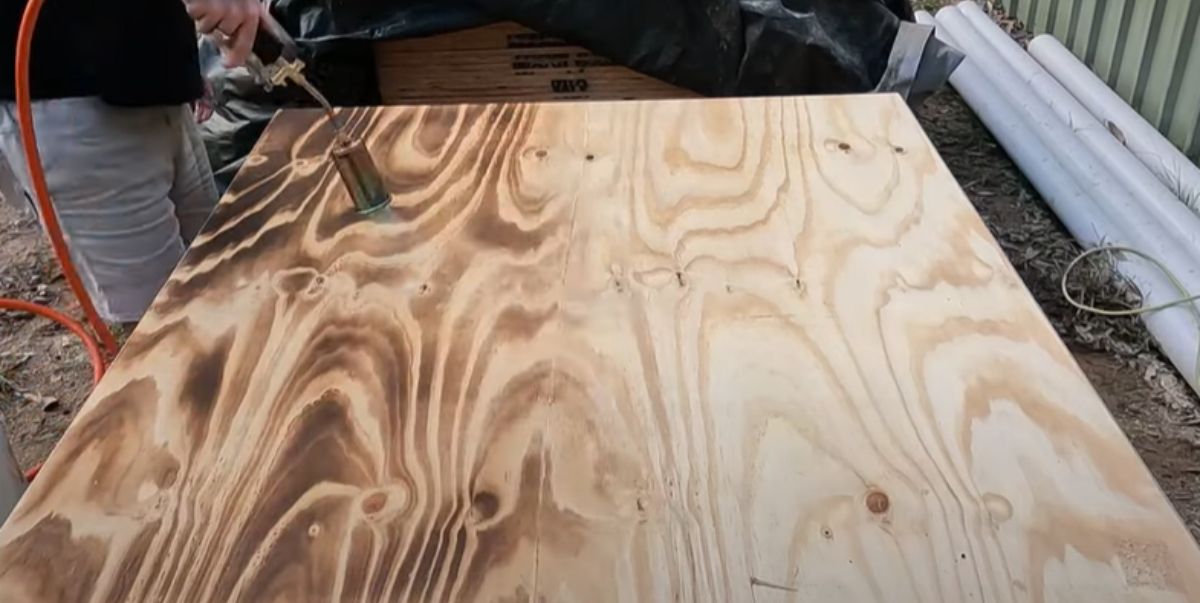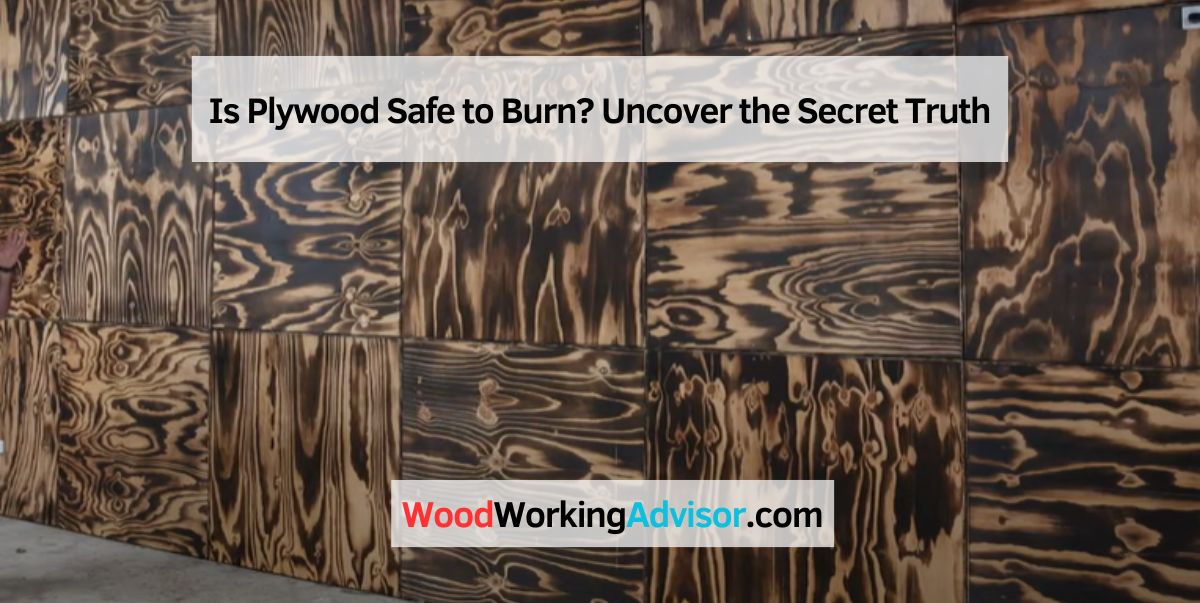Plywood is not safe to burn due to the release of toxic gases and chemicals when it is combusted. Burning plywood is not safe because it releases toxic gases and chemicals when it is burned.
These emissions can be harmful to both human health and the environment. Plywood is typically made with adhesives that contain formaldehyde, which is a known carcinogen. When the plywood is burned, the formaldehyde is released into the air, along with other hazardous substances such as dioxins, furans, and volatile organic compounds (VOCs).
Inhaling these toxic fumes can lead to respiratory problems, eye irritation, and even long-term health effects. Additionally, the release of these harmful pollutants contributes to air pollution and can have a negative impact on air quality. Therefore, it is advisable to avoid burning plywood and opt for safer methods of disposal or recycling.
The Composition Of Plywood
Plywood is a versatile and widely used material in construction and woodworking industries. It is made by gluing together several layers of thin wood known as “plies.” Each of these wood layers is stacked and aligned in a cross-grain pattern to enhance strength and durability. Consequently, plywood offers superior stability and resistance to cracking and warping.
Wood Layers
Plywood consists of multiple layers of wood that are glued together. These layers, known as plies, are typically made from various species of wood, including softwoods like pine or hardwoods like birch or poplar. The grain direction of adjacent layers is perpendicular to one another, resulting in a stronger and more dimensionally stable product. This construction method ensures that plywood remains resistant to splitting, expanding, or contracting due to changes in temperature and humidity.
Glue And Adhesives
The adhesive used in plywood plays a crucial role in the structural integrity of the final product. A strong and durable adhesive is essential to bond the wood layers securely. Commonly used adhesives include phenol-formaldehyde (PF), melamine-urea-formaldehyde (MUF), and urea-formaldehyde (UF). These adhesives are specifically formulated to withstand high temperatures and pressures, making them capable of withstanding the heat produced during combustion without releasing harmful toxins.
Manufacturers adhere to strict industry standards and regulations regarding the type and amount of adhesive used in plywood production to ensure the safety of the end users. Regulatory bodies ensure that plywood with low formaldehyde emission levels is available in the market, which further enhances its safety when burned as fuel.

Toxic Emissions When Burning Plywood
Plywood is often used in construction and DIY projects due to its strength and versatility. However, when it comes to using plywood as fuel for heating or cooking, there are some important considerations to keep in mind. One of the main concerns is the release of toxic emissions that can pose health risks when plywood is burned.
Formaldehyde
Plywood is typically made by gluing together multiple layers of wood veneers with adhesives. One common adhesive used in the production of plywood is urea-formaldehyde. While this adhesive is effective in bonding the veneers, it also contains formaldehyde, a known irritant and potential carcinogen.
When plywood is burned, the heat can cause formaldehyde to be released into the air in the form of a gas. Inhalation of formaldehyde gas can lead to respiratory issues, eye irritation, and, in the long term, increased risk of certain cancers.
Other Chemicals Released
In addition to formaldehyde, burning plywood also releases other potentially harmful chemicals. Plywood products often contain various additives, such as fire retardants and preservatives, that can emit toxic fumes when exposed to high temperatures.
These chemicals can include volatile organic compounds (VOCs) like benzene and toluene, which are known to cause adverse health effects such as headaches, dizziness, and damage to the central nervous system.
Furthermore, the combustion of plywood can produce fine particulate matter (PM2.5) that can enter the lungs and cause respiratory problems, especially in individuals with pre-existing respiratory conditions like asthma.
To minimize the risks associated with burning plywood, it is crucial to avoid using it as a source of fuel. Instead, opt for cleaner alternatives such as natural firewood or environmentally friendly fire logs made from compressed sawdust and other wood waste.
Health Risks Associated With Burning Plywood
Burning plywood can pose serious health risks due to the chemicals and adhesives present in the material. When plywood is burned, harmful substances are released into the air, which can have detrimental effects on respiratory health and lead to long-term health issues.
Respiratory Issues
Burning plywood can result in the release of toxic fumes and particles, which can be inhaled and cause immediate respiratory problems. Exposure to these substances can irritate the lungs and airways, leading to coughing, wheezing, and shortness of breath. Individuals with pre-existing respiratory conditions, such as asthma, may experience exacerbated symptoms when exposed to the smoke from burning plywood.
Long-term Effects
Repeated exposure to the toxins released from burning plywood can have long-term health effects. Prolonged inhalation of these harmful substances can increase the risk of developing chronic respiratory conditions, such as emphysema and bronchitis. Furthermore, the chemicals released during the combustion of plywood may have systemic effects on the body, potentially causing damage to organs and contributing to the development of certain diseases over time.
Safe Alternatives To Burning Plywood
If you have plywood that you no longer need or want to dispose of, it’s important to consider safe alternatives to burning it. Burning plywood can release harmful chemicals and toxins into the air, posing health risks to you and the environment. Fortunately, there are a few different options for recycling or properly disposing of plywood in a safe and sustainable manner.
Recycling Options
Instead of burning plywood, recycling is a great way to ensure that it is repurposed and doesn’t contribute to pollution. Many recycling centers accept plywood, especially if it is clean and free from any coatings or treatments. Check with your local recycling facility to see if they accept plywood, and if so, what their guidelines are. Some centers may require you to remove any nails or hardware before disposing of the plywood.
If there are no recycling centers in your area that accept plywood, consider reaching out to construction companies or DIY enthusiasts. They may be interested in repurposing the plywood for their own projects or know someone who would benefit from it. This way, you can give the plywood a second life and prevent it from ending up in a landfill.
Proper Disposal Methods
If recycling is not an option, it’s important to dispose of plywood properly. Improper disposal can lead to groundwater contamination and other environmental hazards. One of the best ways to dispose of plywood is to take it to a landfill that accepts construction and demolition debris. These landfills are equipped to handle such materials and ensure that they are properly contained. Contact your local waste management facility for information on the nearest appropriate landfill.
Before disposing of plywood in a landfill, make sure you remove any nails, screws, or other hardware. This not only makes it easier for the landfill staff to handle but also helps prevent these items from causing damage to the environment or interfering with the landfill’s operations. Additionally, consider separating the plywood from other construction materials to facilitate proper recycling or disposal.
| Methods | Pros | Cons |
|---|---|---|
| Recycling | Repurposes plywood reduces waste | Not widely available in all areas |
| Donation | Gives plywood a second life | Dependent on finding interested parties |
| Landfill disposal | Properly contained and managed | May contribute to landfill waste |
Burning plywood should always be considered a last resort due to the potential health and environmental risks associated with it. By exploring recycling options and proper disposal methods, you can ensure that your plywood is handled in a safe and responsible way, minimizing harm and promoting sustainability.
Environmental Impact Of Burning Plywood
The environmental impact of burning plywood is a crucial aspect to consider, as it can have significant consequences on air quality and waste management.
Air Pollution
Burning plywood can release harmful pollutants into the air, contributing to air pollution and posing risks to human health. The combustion of plywood can release toxic gases such as formaldehyde, a known carcinogen, as well as volatile organic compounds (VOCs) and particulate matter. These pollutants can irritate the respiratory system and trigger or exacerbate respiratory conditions such as asthma.
Waste Management Concerns
Proper waste management is essential when it comes to disposing of plywood. Burning plywood as a means of waste disposal can create issues in terms of effective waste management. Instead of burning plywood, it is preferable to explore environmentally friendly alternatives such as recycling or reusing. This helps to reduce the amount of waste sent to landfills, conserves resources, and minimizes the associated environmental impact.
Frequently Asked Questions Of Is Plywood Safe To Burn
Can I Burn Plywood In a Wood Burner?
Yes, burning plywood in a wood burner is possible, but it’s not recommended due to the glue and chemicals used in its manufacturing. This could release toxic fumes and damage your wood burner. It’s safer to use untreated wood for burning.
Can You Use Plywood For Wood Burning?
Yes, plywood can be used for wood burning. However, it’s important to note that not all plywood is suitable due to the presence of glue and other chemicals. Make sure to use plywood that is specifically designed for wood burning and does not contain any harmful substances.
What Wood Should You Not Burn In Fireplace?
Avoid burning softwoods like pine, spruce, and cedar in your fireplace. They produce excessive smoke and creosote, which can lead to dangerous chimney fires. Additionally, never burn treated wood, painted wood, or wood coated with chemicals, as they release toxic fumes when burned.
Is Burning Osb Toxic?
Burning OSB releases toxic chemicals like formaldehyde, creating health risks. Proper disposal is crucial.
Conclusion
While plywood can be used as a fuel source, caution is necessary. Its safety for burning heavily depends on the materials used in its construction. It’s important to check for any chemical treatments or adhesives that may release toxins when burned.
Overall, proper research and care is essential for using plywood as a heating fuel.


